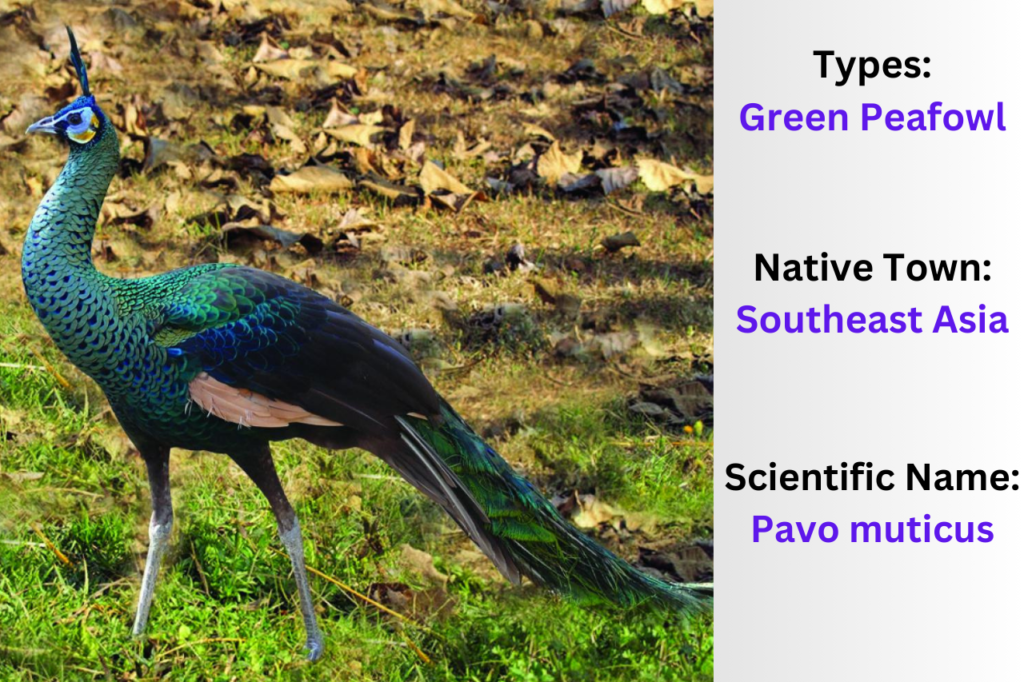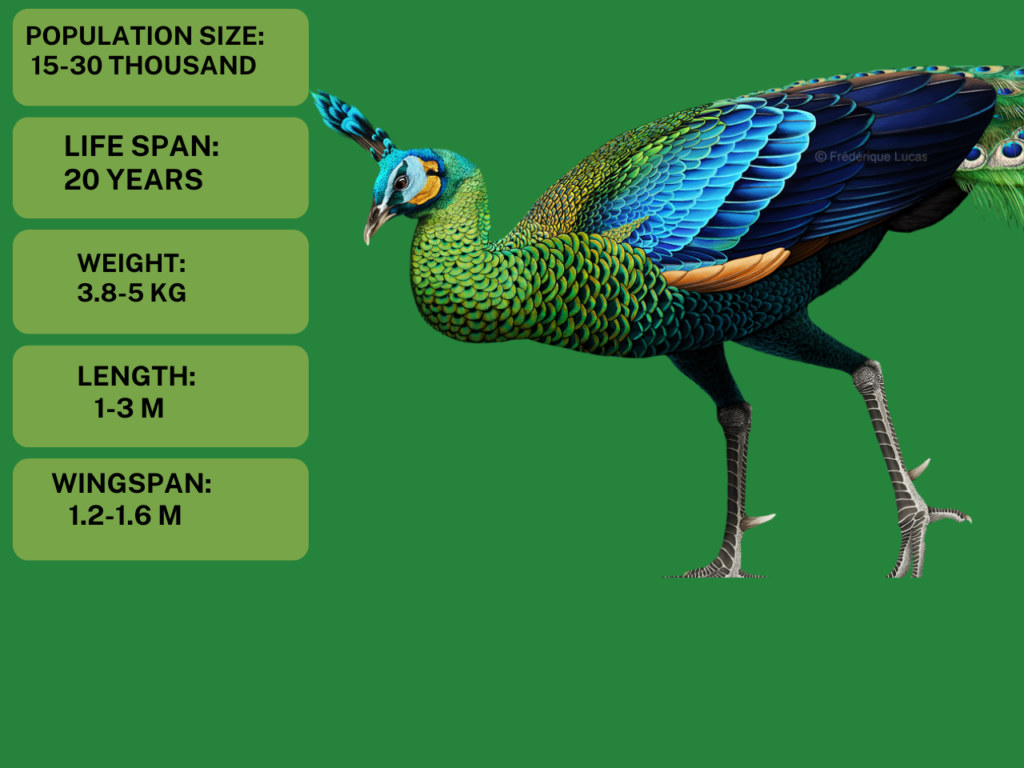Javan Green Peafowl
Javan Green Peafowl, also known by their scientific name Pavo muticus, are a captivating and lesser-known species of peafowl that possess their unique charm and characteristics. While Indian peafowls may dominate the spotlight, exploring the world of Java Green Peafowl reveals a fascinating avian species with distinct features and behaviors.

Green peafowl (Pavo muticus) are one of three species of peafowl. The green peafowl has several wild subspecies, which means they may be found across southeastern Asia. The green peafowl has less pronounced sexual dimorphism than the other two species of peafowl, which means that the plumage of the peahens is comparable to that of the peacock, except the train, of course. The IUCN has classed them as Endangered, partly because of concerns like habitat degradation, poaching, and hunting.
Facts
- Cultural Significance: Javan Green Peafowls are revered symbols of beauty and pride in Southeast Asian cultures, featuring prominently in folklore and traditional art.
- Ecological Role: They play a vital role in their ecosystems by aiding in seed dispersal and serving as prey for predators, contributing to the balance of their habitats.
- Conservation Status: Classified as Near Threatened, Java Green Peafowls face threats such as habitat loss, poaching, and illegal trade, highlighting the need for conservation action.
- Research Efforts: Ongoing scientific research focuses on understanding their breeding habits, habitat requirements, and population dynamics to inform conservation strategies.
- Captive Breeding Programs: Captive breeding initiatives aim to maintain genetic diversity and support population growth, ensuring the long-term sustainability of Java Green Peafowl populations.
- Habitat Conservation: Protecting and restoring their natural habitats through the establishment of protected areas and sustainable land management practices is essential for their survival.
- Education and Outreach: Public education and outreach efforts raise awareness about the conservation needs of Java Green Peafowls, fostering appreciation for their importance in biodiversity conservation.
- Collaborative Conservation: Collaboration among governments, conservation organizations, researchers, and local communities is crucial for addressing threats and implementing effective conservation measures.
Description of Green Peafowl

Javan Green Peafowls exhibit a striking combination of iridescent green and blue feathers, particularly prominent in males, known as Java Green peacocks. These males boast a regal appearance with an elongated neck and impressive plumage. In contrast, female Java Green peafowls, referred to as Java Green peahens, display a more subdued coloration with earthy tones, contributing to their elegance and understated beauty.
Characteristics
Beyond their captivating colors, Javan Green Peafowls are known for their diverse range of vocalizations. They emit various calls, including shrieks and honks, which serve as a means of communication and warning against potential threats. Particularly during the mating season from early spring to late summer, these vocalizations play a crucial role in establishing territories and attracting mates.
Size
Similar to Indian peafowls, Javan Green peacocks and peahens exhibit comparable body sizes, with a notable distinction in the size of their tails. While Java Green peacocks boast tails that can reach impressive lengths, adorned with vibrant feathers, Java Green peahens possess shorter and less extravagant tails, reflecting their more subtle appearance.
Javan Green peacocks boast tails that can extend impressively, measuring up to 180 centimeters (6 feet) in length. These tails, adorned with vibrant green and blue feathers, add to the majestic appearance of the male Java Green peafowl. Conversely, Java Green peahens possess shorter and less extravagant tails, measuring only about 10-15 centimeters (4-6 inches) long, which complements their more subtle and understated appearance.
This discrepancy in tail size contributes to the overall visual distinction between male and female Java Green Peafowls, highlighting the ornate elegance of the males and the more modest allure of the females.
Diet
As omnivores, Javan Green Peafowls have a varied diet comprising both plant matter and small animals. They are known to forage for berries, grass, and various insects, including beetles and worms. Additionally, they may consume larger prey such as snakes and mice, showcasing their adaptability and opportunistic feeding behavior. This diverse diet necessitates a spacious environment to accommodate their foraging needs and ensure their nutritional requirements are met.
Population
The IUCN Red List estimates that there are between 15,000 and 30,000 green peafowl in the world. This comprises between 10,000 and 19,999 adults. According to the IUCN Red List, this species is currently listed as Endangered (EN), and its population is currently declining.
While Javan Green Peafowls may not be as widely distributed as their Indian counterparts, they are protected in their native habitats across Southeast Asia, including Java, Bali, and surrounding regions. Conservation efforts aim to sustain and protect their populations, both in the wild and in captive breeding programs, ensuring their continued existence for future generations to admire and appreciate.
Lifespan
With an average lifespan of around 20-25 years, Javan Green Peafowls can become long-term companions for those who choose to raise them, whether as pets or for conservation purposes. Their longevity underscores their importance in ecosystems and their potential to contribute to biodiversity conservation efforts.
Breeding
Java Green Peafowls typically reach sexual maturity at around three years of age. During the breeding season, which varies depending on their habitat, males engage in elaborate courtship displays to attract females. These displays involve the males flaunting their vibrant tail feathers, spreading them out in a fan-like display while emitting calls to signal their readiness to mate.
Once courtship is successful, the female Javan Green Peafowl will select a suitable nesting site, often concealed in dense vegetation to provide protection from predators. She will then lay a clutch of eggs, usually numbering between four to six, with incubation lasting approximately 28 days. The female diligently tends to the eggs, rotating them regularly to ensure even warmth and protection.
After hatching, the precocial chicks, known as peachicks, are cared for by the female. They are capable of walking and foraging shortly after hatching, although they remain close to their mother for protection and guidance. The peachicks gradually develop their vibrant plumage over time, reaching maturity at around two to three years of age.
Breeding programs and captive breeding efforts play a crucial role in conserving Javan Green Peafowls, helping to maintain genetic diversity and ensure the sustainability of their populations. These programs often involve careful selection of breeding pairs based on genetic compatibility and adherence to conservation guidelines to prevent the loss of valuable genetic traits. Through dedicated breeding initiatives and habitat conservation efforts, we can contribute to the preservation of this magnificent species for future generations to appreciate.
Habitat
Javan Green Peafowls thrive in warm climates and are native to Southeast Asia, where they inhabit diverse habitats such as forests, grasslands, and agricultural areas. While they may not be as common in zoos and wildlife sanctuaries as Indian peafowls, they can still be admired in select facilities worldwide, contributing to public awareness and appreciation of this majestic species.
Behavior
Javan Green Peafowls exhibit fascinating behavior patterns, including intricate courtship displays performed by males to attract potential mates. These displays often involve the spreading and shaking of their vibrant tail feathers while emitting distinctive calls to impress females. Additionally, Java Green Peafowls are known for their communal roosting behavior, where groups of birds gather together at night for safety and social interaction.
Conservation Status
While not as widely studied as some other species of birds, Javan Green Peafowls face threats to their survival due to habitat loss, poaching, and illegal pet trade. Conservation efforts are underway to protect their remaining habitats, establish breeding programs, and combat illegal trade activities to ensure their long-term survival in the wild.
Ecological Role
As integral components of their ecosystems, Javan Green Peafowls play various ecological roles, including seed dispersal through their foraging activities and serving as prey for predators, thereby contributing to the balance of their ecosystems. Their presence in the wild serves as indicators of ecosystem health and biodiversity.
Cultural Significance
Javan Green Peafowls hold cultural significance in the regions where they are found, often featuring in folklore, myths, and traditional art forms. They are revered symbols of beauty, pride, and good fortune in many cultures, with their feathers used in ceremonial attire and decorative items.
Research and Conservation Efforts
Scientific research on Javan Green Peafowls is ongoing, focusing on their behavior, ecology, genetics, and conservation needs. Collaborative efforts between conservation organizations, researchers, and local communities are crucial for the protection and sustainable management of Java Green Peafowl populations.
Care for Green Peacocks
Providing proper care for Java Green Peacocks is essential to ensure their health, well-being, and longevity in captivity. Whether kept in zoos, wildlife sanctuaries, or private collections, following appropriate care guidelines is crucial for meeting their physical, nutritional, and behavioral needs.

Housing Requirements: Java Green Peacocks require spacious enclosures that mimic their natural habitat as closely as possible. The enclosure should include ample space for roaming and foraging, as well as areas for shelter and perching. Ideally, the enclosure should be securely fenced to prevent escape and protect the birds from predators.
Environmental Enrichment: Enrichment activities are essential to keep Java Green Peacocks mentally stimulated and physically active. Providing natural perches, hiding spots, and environmental stimuli such as branches, logs, and foliage can encourage natural behaviors like perching, foraging, and nesting.
Diet and Nutrition: A balanced diet is crucial for the health of Java Green Peacocks. They are omnivorous and require a varied diet consisting of high-quality commercial bird feed supplemented with fresh fruits, vegetables, insects, and small prey items like mice and worms. It is important to provide clean, fresh water at all times.
Veterinary Care: Regular veterinary check-ups are essential to monitor the health of Java Green Peacocks and address any potential medical issues promptly. Routine vaccinations, parasite control, and preventative care measures should be implemented to ensure their overall well-being.
Socialization and Interaction: Java Green Peacocks are social birds and benefit from interaction with conspecifics as well as human caregivers. Providing opportunities for socialization within a compatible group or with other bird species can prevent loneliness and promote natural behaviors.
Environmental Temperature: Java Green Peacocks are adapted to warm climates and should be housed in environments with temperatures ranging from 65°F to 85°F (18°C to 29°C). Providing access to shade and shelter from extreme heat or cold is essential to prevent heat stress or hypothermia.
Behavioral Observation: Regular observation of Java Green Peacocks’ behavior is crucial to monitor their health, detect any signs of illness or distress, and address behavioral issues promptly. Changes in appetite, activity level, plumage condition, and social interactions should be noted and investigated as needed.
Video Tutorial About Green Peafowl
Conclusion
In conclusion, Javan Green Peafowls are not only visually stunning birds but also possess complex behaviors, ecological significance, and cultural importance. Understanding and appreciating these aspects of Java Green Peafowls are essential for their conservation and continued existence in the wild. Through collaborative conservation efforts and public awareness, we can ensure that these majestic birds thrive for generations to come.
